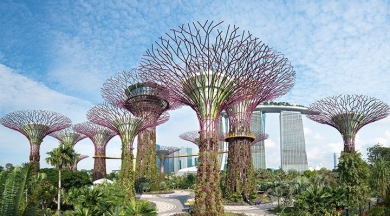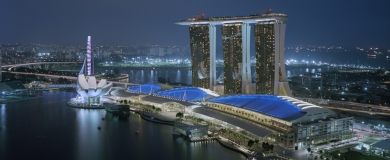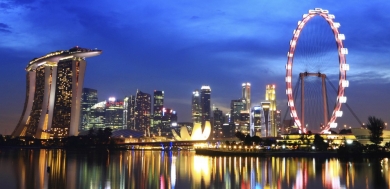Singapore is a cosmopolitan city- with Chinese opera, feng shui and chopsticks existing harmoniously alongside saris and Hindu temples. A melting pot of cultures, Singapore is Asia’s richest, most dazzling and smallest country. This Garden city has a bustling and pulsating nightlife, fantastic shopping, scrupulously clean surroundings and some of the best food you’ll ever taste.
Everything goes towards making Singapore an extremely interesting country- tiny compared to giants like China and India, but one of Asia’s most delightfully attractive tourist destinations. So travel to Singapore to discover this very interesting Asian city.
How to get to Singapore ?
How to get to Singapore by Air
Singapore is well connected by air to the rest of the world being as it is an important city for trade and holidays. All major airlines feature Changi Airport on their schedules and provide connections from many places. The state of the art airport is among the best in the world.
How to get to Singapore by Rail
Trains run back and forth from Malaysia and Thailand to Singapore everyday.
How to get to Singapore by Road
Two bridges connect Malaysia to Singapore making it possible to drive into the country if you are in the vicinity. The drive over the glimmering sea is beautiful. Coaches do this route too.
How to get to Singapore by Sea
You can come to Singapore over water from Malaysia, Thailand and Indonesia. Frequent ferry services from Johor (Malaysia), Batam and Bintan (Indonesia) make this very convenient.
Best Time to Visit Singapore
Singapore’s pretty much a year-round destination: there are no dramatic variations in temperature, and the amount of rainfall too doesn’t vary to any great extent, although it is somewhat higher between November and January. If you’re a food buff or love shopping, then the best time to visit Singapore would be around July as that's when the Great Singapore Sale and the Singapore Food Festival are held.
Climate
Singapore’s climate is typically tropical - hot and humid twelve months of the year. Daytime temperatures hover around 30°C (often higher), while nights are generally not cooler than 20°C. It’s muggy too - the humidity level is around 75% on most days. There is a slight increase in the rainfall between November and January, but there are generous spurts of sunshine too, so don’t worry about getting too wet.
Sightseeing in Singapore
Sentosa is approachable by bus, cable car, or hired cars. Sentosa’s literally chock full of attractions- there are water amusement parks, landscaped gardens, beach clubs with live throbbing music, a butterfly garden, an ethnic village, a fabulous aquarium (Underwater World) and a huge 37m high Merlion statue. Sentosa is an exhilarating daylong trip that will leave you tired, joyous and satisfied.
The Singapore Zoo, one of the best in the world, spreads over 28 hectares and houses over 3000 creatures- mammals, birds and reptiles. The zoo has a very animal-friendly with barriers like moats and rock walls instead of wire cages. Two of the main attractions are the `Fragile Forest’- an excellent display of endangered ecosystems, and the orang-utans enclosure, where breakfast (or tea) with the orang-utans is a real crowd-puller. Try it- you wouldn’t have had more interesting partners at the tea table.
The Night Safari is the only one of its kind in the world – a night zoo; you can travel through either on foot (there are three walking trails) or by tram. The safari park is set in eight geographical zones and includes a bat enclosure, a leopard trail, and regular animal shows.
Jurong Bird Park is easily one of Singapore’s best-known attractions. It stretches over 20 hectares and is South East Asia’s largest bird park. There are regular bird shows, and a simulated thunderstorm everyday at noon. Go armed with bird feed and lots of camera film- it’s a great place.
The park has over 8000 birds of more than 600 species, including some colourful (and noisy!) collections of owls, kiwis, flamingos, parrots and horn-bills, besides the world’s highest man-made waterfall.
Adjacent to each other, the Japanese and Chinese gardens are lovely representations of two very different landscape designs. The Japanese Garden is typically minimalist, with Zen rock gardens, shrubs, and quiet summerhouses. The Chinese Garden, on the other hand, has a tea gallery, opulent imperial-style architecture and a Penjing Garden. The Singapore Botanical Gardens will also delight the nature lover with its beautifully laid out gardens
The Haw Par Villa Tiger Balm Gardens is a treat for anyone who’s fascinated by Chinese mythology. The gardens are spread out over extensive landscaped parkland, and feature interesting stories. A popular attraction is the 'Ten Courts of Hell’- a Chinese representation of the afterlife.
Come to Merlion Park for a breath of fresh air and a walk down memory lane. The Merlion, half-lion, half-fish, is symbolic of Singapore’s past: the lion stands for the ‘Singha’ (Sanskrit for lion) after which `Singapura’ was named by a long-forgotten Sumatran prince, and the fish represents Singapore’s past as a maritime trading post (which it still is, to a great extent). The Merlion has come to be a symbol of Singapore Tourism, and the huge white statue, surrounded by a park, is one of the city’s important tourist attractions.
The Chinese Ming dynasty was renowned for the exquisite porcelain that was produced during its reign. In the Ming Village in Singapore porcelain is still made by artisans using the ancient techniques developed at the time of the Ming emperors. You can buy pottery and also watch the artisans at work.
Orchard Road is Singapore’s main shopping hub with lots of stores all along the way; the larger shopping centres include Orchard Plaza, Ngee Ann City and Orchard Towers. At night, it gets transformed into the entertainment district of town - loud music, bright lights and merry crowds- with bars, discotheques, and nightclubs by the dozen. Among these, the most popular ones include Sparks, Pleasuredome, Planet Hollywood and Hard Rock Café. Either way, day or night, it’s a vibrant, `happening’ place to be.
Do pay a visit to the legendary Raffles hotel and enjoy a meal or a cup of tea and relive history in these surroundings. Other places to see would be the recently opened Universal Studios where one can see the sets of their favoutite movies. A ride on the Singapore Flyer will give you a view of Singapore from a different perspective, and if you are sweating in the Singapore sun, then pay a visit to the Snow City and take a roll in the snow to cool off!
Little India, all the way from Lavender Street to Rochor Canal, is inhabited by immigrants from Madras, Calcutta and Malaya- all of them contributing to making this part of Singapore a very Indian locality. You can see and buy lots of Indian handicrafts, sample some delicious food, and catch some typically Indian sights- especially in the Hindu temples of the area.
On the coast of Singapore, Mount Faber is the point from which cable cars go to Sentosa. Its main attraction is the splendid view it offers of Singapore, the harbour, and the nearby islands. The mount has a convenient tea house for weary tourists and is a nice place to take a breather after all the hectic tramping around the sites of Singapore.
Other than these, there are any number of parks, gardens, Buddhist and Hindu temples, museums and memorials to see around Singapore. Take your pick- there’s something for everybody.
Packages

Magical Singapore
Singapore Packages

Singapore Delight
Singapore Packages

